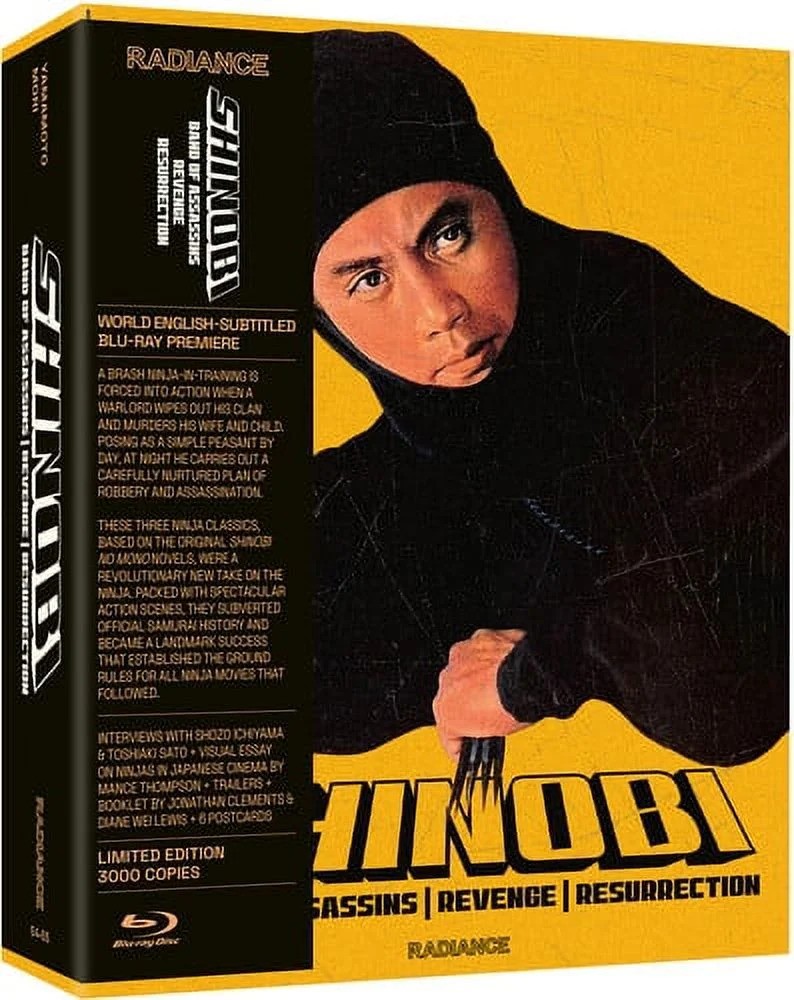In Shinobi: Band of Assassins, Goemon Ishikawa (Ichikawa Raizo) is a promising young pupil who is shown particular favor by shadowy ninja clan master Sandayu (Yunosuke Ito). Sandayu secretly sets up Goemon in a scheme to push him to assassinate the Japanese warlord Ode Nobunaga who is trying to consolidate power amidst the feuding territories. Shinobi: Revenge catches up with Goemon as he attempts to settle down with a wife and child. But ruthless warlord Nobunaga will not let Goemon rest in peace, determined to wipe out all traces of any ninja who opposes his rule. The film ends with Goemon’s fate in doubt, ensnared in a nefarious trap. Shinobi: Resurrection picks up right where Revenge left off with Goemon making a narrow escape and swearing vengeance against those who shattered his happy family life and tried to boil him alive.
The original Goemon Shinobi trilogy stands as one of the single most influential sets of films to depict that iconic cinematic character, the ninja. But rather than the sleek and stylish theatrics of the ’80s Cannon flick American Ninja or the multi-colored nonsense of the cut ‘n’ paste crap jobs of Godfrey Ho, Shinobi grounds the ninja in realism, attempting to depict these silent assassins as they truly were. Blending into the shadows and using stealth and secrecy as their primary skills, for the first time in cinema, we witness the use of that classic ninja weapon the shuriken. James Bond fans will recognize that famous ninja trick of pouring poison down a thread into the mouth of a sleeping victim (Roald Dahl who wrote the Bond film You Only Live Twice was reportedly a fan of the Shinobi films and used them as an influence). The first film especially really relishes in the shadowy world of the ninja, using a kind of very high contrast lighting to show the intricate details of the activities of the ninja while allowing them to melt into the darkness when needed. The films aren’t all ninja action though. Band of Assassins and Revenge, directed by Satsuo Yamamoto, are both packed full of twists, turns, double crosses, triple crosses, political machinations and warring factions., throwing characters and names at us at such a pace that at times it can be hard to follow. Revenge dials up the cruelty of the villains, having them commit an unspeakable act that we the audience are also forced to witness and giving Goemon more of a true driving force compared to the duplicitous conniving of the first film. Despite that, Revenge still contains much of the political maneuverings and covert backstabbing that made the first film such a dense experience. The third film, Resurrection, directed by Kazuo Mori, takes a much more straight forward and focused approach. In some ways, this is more of an investigative espionage thriller than a stealthy ninja film. Goemon spends much of the time discovering the identities of those who have wronged him and systematically dealing with them. This deliberate pacing isn’t quite as satisfying as when the first two films really come together, but it’s made up in the fact that it’s more immediately engaging with its streamlined plot. Plus it adds another famous Japanese historical figure, the great Hattori Hanzo! Regardless, all three films are excellent and well worth watching for ninja fans looking to go back to the cinematic roots which sprang forth so much awesomeness.
These new hi-def transfers provided to Radiance by Kadokawa Corporation look quite nice overall. These are dark films, and the deep black levels come through quite well with lots of details in the image and a healthy amount of grain without going overboard. The audio, uncompressed Japanese mono tracks, for the most part sound very clean and unobtrusive. There is a slight buzzing noise noticeable during certain quieter scenes but only if you are really listening. Overall, the technical specifications are quite admirable. We have several nice extras to dig into as well. first we have a new interview with the artistic director of the Toyko International Film Festival Shozo Ichiyama who discusses the career of director Satsuo Yamamoto. It’s a nice overview and adds context into what interested Yamamoto in the Shinobi project. We also have an 18-minute visual essay with Mance Thompson on the history of the Japanese ninja film. A very nice extra that goes all the way back into the silent era film and illustrates the importance of the Shinobi films in the evolution of the ninja sub-genre. Additionally we have an interview with film critic Toshiaki Sato discussing the career of actor Raizo Ichikawa. For physical extras, we have 6 postcards featuring black & white stills from the film as well as a booklet featurings essays by author Jonathan Clements and author and Associate Professor of Film & Media Studies at Washington University Diane Wei Lewis as well as an interview with cinematographer Yasukaze Takemura on the difficulties of shooting Shinobi and the techniques used in making it.
I am absolutely delighted to have this great trilogy of seminal ninja films finally available in an excellent package courtesy of the fine folks at Radiance Films. If you are a lover of the genre as I am, this release should be an instant purchase.

